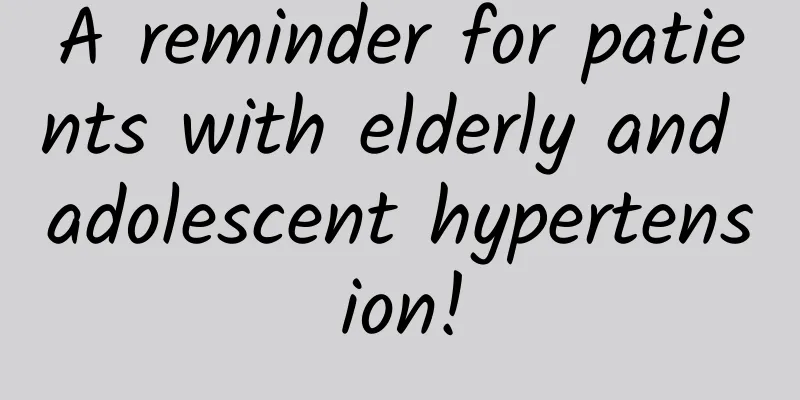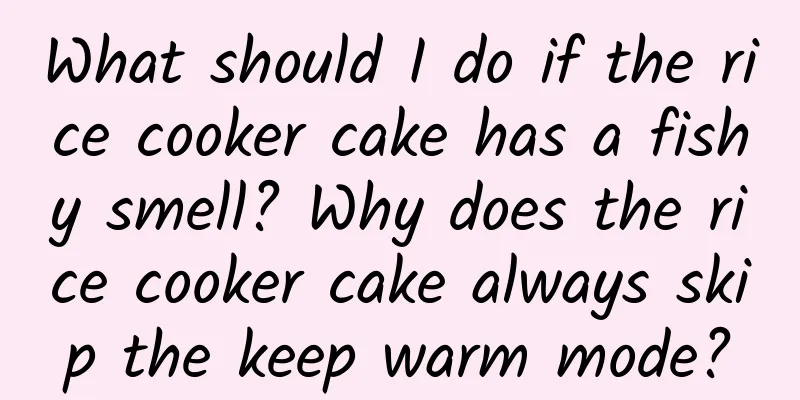A reminder for patients with elderly and adolescent hypertension!

|
As a common and frequently occurring disease in today's society, hypertension has received more and more attention. However, people's understanding of hypertension may be limited to increased blood pressure and damage to important organs such as the heart, brain and kidneys. However, people do not know that hypertension occurs at different ages and in different genders and has its own unique characteristics and prevention and treatment methods. Today we will talk about hypertension knowledge for the elderly and young people. China often emphasizes respecting the elderly and loving the young, so let's start with senile hypertension. First of all, let's talk about what is senile hypertension. As the name suggests, it refers to the cardiovascular syndrome of elderly hypertensive patients with their own unique characteristics and treatment methods. As for the specific standards of the elderly and hypertension, we will explain it in detail in the diagnostic criteria later. Let's first look at the incidence of hypertensive diseases in the elderly. Survey data show that the blood pressure control rate of elderly patients in the hypertensive population is lower than that of younger patients. The incidence of hypertension in female elderly patients is higher than that in men, and blood pressure control is more difficult than that in men. The specific reasons are still unclear. Elderly hypertension is more prone to target organ damage, cardiovascular disease, and new cardiovascular events than ordinary hypertension. According to relevant statistics, renal artery stenosis ranks first among the secondary factors of elderly hypertension, followed by sleep apnea. In addition, thyroid function will also affect senile hypertension. In contrast, the incidence of aldosteronism in the elderly population is relatively low. In my country, the prevalence of hypertension in people aged ≥60 years is 58.9%, and the awareness rate, treatment rate and control rate are 53.7%, 48.8% and 16.1% respectively. So how do we determine whether we or our family members suffer from senile hypertension? This brings us to the specific diagnostic criteria and characteristics of hypertension that we just talked about. The latest international diagnostic criteria for senile hypertension are age ≥ 65 years, blood pressure systolic blood pressure ≥ 140 mmHg and/or diastolic blood pressure ≥ 90 mmHg in a sitting position for continuous or more than 3 times on different days. (If systolic blood pressure ≥ 140 mm Hg and diastolic blood pressure < 90 mmHg, it is defined as isolated systolic hypertension (ISH). If the patient is ≥ 80 years old, it is defined as advanced hypertension). Although the internationally recognized definition of old age is ≥ 65 years old, in fact, the data on senile hypertension in my country are all ≥ 60 years old. Senile hypertension is different from ordinary hypertension. It is mainly characterized by increased systolic blood pressure, which is what we usually call increased high blood pressure, while the increase in low blood pressure is not obvious, which will lead to increased pulse pressure, which is relatively more serious damage to our target organs. Senile hypertension also has the characteristic of unstable blood pressure, that is, large fluctuations in blood pressure. For example, when we change our body position, or measure blood pressure before and after meals, the blood pressure fluctuates greatly. Another characteristic of elderly hypertensive patients is abnormal circadian rhythm of blood pressure. Most of us have a dipper-shaped blood pressure fluctuation, that is, there are small peaks in blood pressure throughout the day at 6-8 am and 16-18 pm, but elderly patients with hypertension do not have this characteristic, which makes our treatment and medication more difficult. Finally, because the underlying diseases and overall conditions of elderly patients are relatively poor, elderly hypertension often coexists with coronary heart disease, heart failure, cerebrovascular disease, renal insufficiency, diabetes, etc. Compared with other hypertension, the biggest harm of senile hypertension is that it causes more serious damage to target organs. Because the systolic blood pressure rises more, the heart load increases, making heart failure and arrhythmia more likely to occur. Long-term high pulse pressure difference leads to increased water and sodium retention in the kidney structure, while affecting renal perfusion and aggravating the decline of renal function. Long-term hypertension leads to oxidative stress damage to the vascular endothelium or cerebral blood vessels, secondary to brain structure and function damage, and can also lead to white matter degeneration. Brain diseases occur. Due to the particularity of the onset of hypertension in the elderly, its control goals and corresponding treatment plans are also different from other hypertensive diseases in clinical practice. The main goal of treating hypertension in the elderly is to protect target organs and minimize the risk of cardiovascular and cerebrovascular events and death. For the elderly aged 65 to 79, the first step should be to reduce blood pressure to <150/90 mm Hg. If tolerated, the treatment goal for most patients is blood pressure <140/90 mm Hg (ESC guidelines standard is systolic blood pressure 130-139 mm Hg, diastolic blood pressure <80 mm Hg). Those aged ≥80 should be reduced to <150/90 mm Hg; if the patient's systolic blood pressure is <130 mm Hg and tolerates well, treatment can be continued without adjusting blood pressure. For the choice of treatment options, the latest expert consensus recommends the combined use of diuretics, calcium channel blockers (CCBs), angiotensin-converting enzyme inhibitors (ACEIs) or angiotensin II receptor antagonists (ARBs), which can be used initially or in combination with drug treatment, starting with a small dose and gradually increasing to the optimal dose to improve patient compliance with medication. Diuretics are recommended for the initial and combined antihypertensive treatment of elderly patients with hypertension, especially for patients with concomitant heart failure and edema. Low-dose thiazide diuretics are commonly used. However, adverse reactions are dose-dependent, and high-dose diuretics can also affect glucose and lipid metabolism and induce electrolyte disorders. CCB is suitable for elderly patients with isolated systolic hypertension. The main adverse reactions include edema, headache, facial flushing, gingival hyperplasia, constipation, etc. ACEI/ARB is recommended for elderly hypertensive patients with coronary heart disease, heart failure, diabetes, chronic kidney disease or proteinuria. The most common adverse reaction of ACEI is dry cough. Those who cannot tolerate it can use ARB instead. β-blockers are used for patients with concomitant coronary heart disease, chronic heart failure, tachyarrhythmia, and increased sympathetic activity. Start with a low dose and adjust the dose according to blood pressure and heart rate. α-blockers are not the first choice, but can be used in patients with concomitant prostatic hyperplasia or refractory hypertension. Be alert to the occurrence of orthostatic hypotension. Next, let's talk about hypertension in children and adolescents. Hypertension in children and adolescents refers to people under the age of 18 whose systolic blood pressure (SBP) and/or diastolic blood pressure (DBP) is higher than 95% or more of children and adolescents of the same age and gender. Because primary hypertension in children and adolescents rarely causes lesions in target organs such as the heart, brain, and kidneys in the short term, it is different from hypertension in adults, which is defined based on risk data. Currently, internationally, hypertension in children and adolescents is defined and classified based on their blood pressure percentile distribution: Normal blood pressure: average SBP and/or DBP is less than the 90th percentile of the same sex in the same age group. Prehypertension: Mean SBP and/or DBP between the 90th and 95th percentiles for the same age and sex. Stage 1 hypertension: Mean SBP and/or DBP > 95th percentile of the same sex in the same age group but < 99th percentile + 5 mmHg. Stage 2 hypertension: mean SBP and/or DBP>99th percentile of the same gender in the same age group + 5 mmHg. Hypertension that occurs during childhood and adolescence is mainly primary hypertension, which is mostly manifested as a mild increase in blood pressure levels (grade 1 hypertension), usually without discomfort and obvious clinical symptoms. Unless blood pressure is measured during regular physical examinations, it is not easy to detect. The proportion of primary hypertension increases with age, and hypertension that occurs around puberty is mostly primary. The hazards of hypertension in children and adolescents also have their own characteristics. About 30% to 40% of children and adolescents diagnosed with hypertension can be found in early changes of target organ damage, mainly changes in heart structure. Other changes include vascular changes such as thickening of blood vessel walls, reduced elasticity of large and medium arteries, and then decreased kidney function and retinal arteriosclerosis. Hypertension in children can persist into adulthood. Without intervention, about 40% of hypertensive children develop into adult hypertensive patients. Hypertensive children have a significantly increased risk of cardiovascular and kidney diseases in adulthood. For primary grade 1 hypertension in children and adolescents, only lifestyle intervention can be used for treatment, including weight control, diet adjustment, and exercise. Most patients with grade 1 hypertension can achieve blood pressure control standards after lifestyle intervention. For grade 2 hypertension or when there is target organ damage, drug treatment is required. The principle of drug treatment for hypertension in children is to start with a low dose and a single drug, while taking into account individualization, adjusting the treatment plan and treatment duration according to the efficacy and changes in blood pressure levels, and using combination drugs when necessary. Once secondary hypertension is diagnosed, it is necessary to actively treat the primary disease and carry out antihypertensive treatment at the same time. Although the types of antihypertensive drugs for children and adolescents are the same as those for adults, we have introduced them in detail in hypertension in the elderly. However, my country's State Food and Drug Administration (CFDA) has its own special standards and requirements for antihypertensive drugs for children. Among them, ACEI is one of the most commonly used antihypertensive drugs for children, but the only drug approved by CFDA for children is captopril. Whether it is hypertension in the elderly or hypertension in children and adolescents, long-term high blood pressure is very harmful to patients. Therefore, we must detect, intervene and treat early. Adopt individualized treatment plans. Adhere to lifestyle intervention for a long time to maximize our quality of life. References [1] 2020 Expert Recommendations on Clinical Diagnosis and Treatment of Special Types of Hypertension/Chinese Association for Research and Advancement of Chinese Medicine (CRACM) [2] 2011 ACCF/AHA Expert Consensus on Hypertension in the Elderly/Department of Geriatrics, Peking University First Hospital/Liu Meilin and Wu Xiaojing [3] Interpretation of the Guidelines for Rational Medication Use in Hypertension - Treatment Principles and Drug Selection for Common Special Types of Hypertension / Department of Cardiology, The First Affiliated Hospital of Dalian Medical University / Jiang Yinong, Song Wei [4] The latest American guidelines for the diagnosis and treatment of hypertension in children and adolescents / Department of Pediatrics, Peking University First Hospital / Qi Jianguang, Du Junbao [5] Chinese Hypertension Prevention and Treatment Guidelines Revision Committee, Hypertension Alliance (China, Chinese Medical Association Cardiology Branch, Chinese Medical Association Hypertension Professional Committee). Chinese Hypertension Prevention and Treatment Guidelines (2018 Revised Edition). Chinese Journal of Cardiology, 2019. [6] Chinese Medical Association Pediatrics Branch. Guidelines for the diagnosis and treatment of pediatric cardiovascular diseases, 1st edition [M]. People's Medical Publishing House, 2015. [7] Flynn JT, Kaelber DC, et,al. Clinical Practice Guideline for Screening and Management of High Blood Pressure in Children and Adolescents. Pediatrics, 2017, 140(3):e20171904 |
>>: The biggest wish of these autistic families: to live one day longer than their children
Recommend
Is such a "happy" holiday really good for children? - Focus on childhood obesity
Author: Huo Liang, Associate Professor, Shengjing...
Why does PMS occur?
Menstruation is a very important physiological ph...
What should pregnant women do if they have blood in their urine?
We all know that a woman's body will undergo ...
What are the harms of abortion?
Today's social concepts are more open. If you...
Can I have sex when I am 5 months pregnant?
A woman has to be pregnant for ten months, during...
Eight months pregnant lower body pain
Although pregnant women will have pregnancy react...
What fish can be caught after the winter solstice? What should be paid attention to when fishing during the winter solstice?
We all know that fishing is a common leisure acti...
6 weight loss exercises suitable for menstruation
Menstruation is a special period for women. Durin...
Which season is best for calcium supplementation? The best season for calcium supplementation
Calcium is one of the important elements needed b...
What is the reason for the lack of endometrium?
Many women will experience symptoms of thin endom...
What are the reasons for my girlfriend's delayed menstruation and related examinations?
Menstruation is a manifestation of the physiologi...
Stay away from digestive tract infectious diseases, you need to know this secret
"We pay a lot of attention to food hygiene, ...
Reasons for early and delayed menstruation
Most women have their menstruation delayed or adv...
Bleeding at 11 weeks of pregnancy
Pregnancy is very important for every female frie...
How many days is normal for a woman's menstrual period?
For normal women of childbearing age, the menstru...









